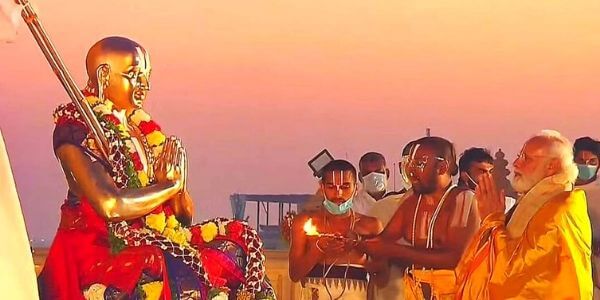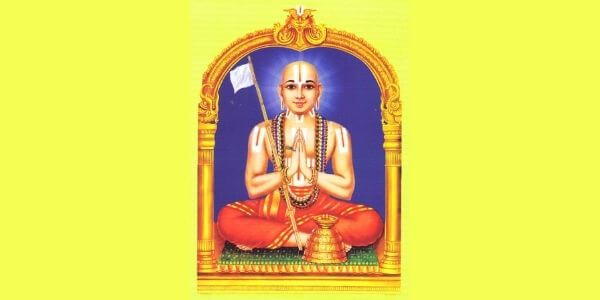The Statue of equality in Hyderabad is discussed in length here. This topic will assist you in your UPSC preparation by providing information about the Statue of equality in Hyderabad, including who was Sri Ramanujacharya (Ramanuja statue), the Statue of equality height, and why it is known as the Statue of equality. He worked relentlessly for the betterment of mankind, believing that all individuals are equal regardless of nationality, gender, color, caste, or faith. There are a few more critical facts to consider. While reading this essay, make a list of the most significant points.
Introduction
The Ramanuja statue also called the Statue of Equality is a statue of the 11th-century vaishnavaite Ramanuja, which is located on the grounds of the Chinna Jeeyar Trust in Muchintal, Hyderabad. The Statue is the world’s second-tallest seated Statue. The trust conceived the statue idea to celebrate Ramanuja’s birth 1000 years ago. The project, which is said to have cost Rs 1,000 crore, was partially funded through devotee donations.
The Prime Minister recently dedicated the Statue of Equality, a Ramanujacharya statue on the outskirts of Hyderabad, Telangana. Here you can find all The important UPSC Exam Topics to study.

Who was Sri Ramanujacharya?
In Sriperumbudur, Tamil Nadu, Ramanujacharya, a Vedic philosopher and social reformer, was born in 1017. He was given the name Lakshmana at the time of his birth. Ilaya Perumal, which means “radiant one,” was another nickname for him. He campaigned for equality and social justice throughout India. His preachings re-energized the Bhakti movement by encouraging various Bhakti schools of thought. Among the poets who have recognized him as an influence are Annamacharya, Bhakta Ramdas, Thyagaraja, Kabir, and Meerabai. Sri Ramanujacharya’s devotional, philosophical ideas inspired the Bhakti movement tremendously. Temples were opened to all people by Sri Ramanujacharya, including those who were subjected to great discrimination. Bhasya on the Brahma Sutras and the Bhagavad Gita, all in Sanskrit, are among Sri Ramanujacharya’s literary works.
Shri Bhashya, Vedarthasangraha, and the Bhagavad Gita Bhashya are three of Ramanuja’s most famous writings, and He went on to produce the navaratnas, a collection of nine scriptures, as well as many Vedic commentaries.. He also emphasized the need to be in sync with nature and not over-exploiting it. To learn all about the UPSC exam, Click Here.
The Navrathnas are nine scriptures written by Sri Ramanujacharya.
- Vedartha Sangraha: A work articulating the Visishtadvaita tenets, which are a reconciliation of various opposing srutis.
- Shri Bhashya: Sri Bhashya is a thorough commentary on the Vedanta Sutras written by Sri Bhashya. Sri Bhashyam, the most extraordinary commentary on the Bramha Sutras, is Sri Ramanuja’s magnum opus. This colossal contribution was one of Sri Ramanujacharya’s three wishes for Sri Yamunacharya, His respected mentor and Guru, who passed away even before seeing Sri Ramanuja in person.
- Gita Bhasya: A commentary on the Bhagavad Gita in depth.
- Vedanta Dipa: A brief commentary on the Vedanta Sutras by Vedanta Dipa.
- Sriranga Gadya: Self-surrender manuals to Lord Vishnu.
- Saranagati Gadya: A prayer of complete surrender to Lord Srimannarayana’s lotus feet.
- Nitya Grantha (Nitya Grantha): A small guidebook aimed at guiding devotees through their daily prayers and activities.
- Shri Vaikuntha Gadya: Defines Shri Vaikuntha Loka and the freed souls’ situation.
- Vedanta Sara: Another beginner-friendly commentary on the Vedanta Sutras.

Why is it called the Statue of Equality?
Ramanuja preached social equality among all aspects of society and encouraged temples to open their doors to everyone, regardless of caste or social standing, at a period when many castes were denied entry to temples. In addition, He gave education to those who did not have it. His biggest gift is the concept of “vasudhaiva kutumbakam,” which means “all the universe is one family.” From temple podiums across India, he preached his principles of social equality and universal brotherhood for decades.
He welcomed both the social outcasts and condemned them, Sri Vaishnavam Sampradaya, which offers universal salvation through devotion to God, compassion, equality, humility, and mutual respect was his message. Ramanujacharya liberated millions of people from social, gender, cultural, educational, and economic oppression based on the underlying premise that every human being is equal regardless of nationality, gender, color, caste, or creed.
Women were once forbidden from praying or chanting God’s name! It’s unimaginable, yet it’s true! Scriptures, rituals, and slokas were not taught to them. We’re talking about a time when scriptures were the dominant source of education in Vedic civilization, which was over 1000 years ago. This was prohibited to women! Believe it or not, males did not learn in front of ladies in order to keep their knowledge hidden!!! Despite the fact that women have smashed many glass ceilings, we are still debating gender equality. In those difficult days, Ramanujacharya showed concern for women and provided learning outlets for them.
This holy personality has purified the world with his presence for over a thousand years. Yet, without giving him credit, the world is promoting his ideology. As a result, his name is shrouded in mystery. As a result, the mystical essence is lacking, and society’s values are vanishing. That is why the Equality Statue was created.

About Statue of Equality
- The Statue of Equality is fashioned of a five-metal alloy known as ‘Panchaloha,’ which consists of gold, silver, copper, brass, and zinc.
- In a seated position, the Statue is the world’s second-highest Statue. The Buddha statue in Thailand is the world’s tallest sitting Statue, standing at 301 feet.
- Shri Ramanujacharya sits on a massive Lotus in the Statue of Equality, sitting upright with a charming grin and uniting his hands at his chest. The ‘thiruthandam’ (flag) is draped across Ramanuja’s body, with the’sadari’ (God’s feet) placed beneath him.
- The basement houses a Vedic digital library and research center, which is mounted atop a 54-foot high base building called ‘Bhadra Vedi.’
- Numerous old Indian scriptures, a theatre, and an educational exhibition with several Ramanujacharya works are also housed within the structure.
- A Ramanujacharya temple covering an area of roughly 300,000 square feet has also been built in the complex, where a 120 kg gold deity will be installed for regular worship. The 120 kgs are thought to represent the saint’s lifespan of 120 years.
- Sri Chinna Jeeyar Swami of Sri Ramanujacharya Ashram is the creator of the Ramanuja statue.
Some Important Points
- The height of the Statue of equality Hyderabad is 216-feet tall.
- It is one of the world’s tallest metallic statues in a sitting position.
- The Statue of Equality is located near the Hyderabad International Airport in Shamshabad and was built in Muchintal, a village in Telangana. The foundation stone for the edifice (Tower) was set in 2014 by Sri Chinna Jeeyar Swami of Sri Ramanujacharya Ashram, who conceptualized it.
- He preached the Sri Vaishnavam Sampradaya, which promotes universal redemption via God-centered devotion, equality, humility, compassion, and mutual respect.
- India is commemorating its 1,000th birthday as the ‘Festival of Equality,’ honoring the belief that the entire globe is one family or ‘vasudhaiva kutumbakam.‘
- The massive monument is also surrounded by replicas of 108 Holy shrines from around the country, including Tirupati, Srirangam, Dwaraka, and Badrinath.

Conclusion – Statue Of Equality
In this essay, we have covered all of the details of The Statue of Equality, who was Sri Ramanujacharya, the Statue of equality height, Ramanuja statue, and other information that will help you with your IAS examination preparation in the article. His appearance and words have the ability to inspire society. Sri Ramanujacharya Ji’s knowledge is a priceless cultural and historical asset. As a result, we hope to rehabilitate and maintain the teachings of this great philosopher through this Statue of Equality.
FAQs – Statue Of Equality
Sri Ramanujacharya is a timeless icon of equality for social reformists all across the world, and his statue is known as the Statue of Equality.
In Sriperumbudur, Tamil Nadu, Ramanujacharya was born in 1017. He was an Indian philosopher, Hindu theologian, social reformer, and one of the most influential representatives of Hinduism’s Sri Vaishnavism tradition. The Bhakti movement was influenced by his conceptual foundations for devotionalism.
The 216-foot-tall is the Height Statue of Equality. It is in a 45-acre complex on the outskirts of Hyderabad.
Vishishtadvaita is a Vedanta school of philosophy that is non-dualistic and It is a non-dualism of the qualified whole in which Brahman is recognized as the Supreme Reality alone, yet it is characterized by plurality. It can be defined or expressed using terminology like qualified monism, attributive monism, or qualified nondualism. It’s a philosophical school of Vedanta that asserts that all diversity is subsumed by an underlying unity.
Editor’s Note | Statue Of Equality
In conclusion, we have included all relevant facts in this essay related to the Statue of equality, Sri Ramanujacharya, Height of Statue of equality and other details. We hope you were able to take some notes on the UPSC topic of the Equality Statue. This will help you earn good grades on your upcoming exam. As a result, we recommend that you make a list of all the important points that you can review during the exam. You can only fail if you give up. You go one step closer to success every time you fail. As a result, keep going. If you give it your all, your dreams will come true. It’s all up to you. Best wishes for your examinations.







